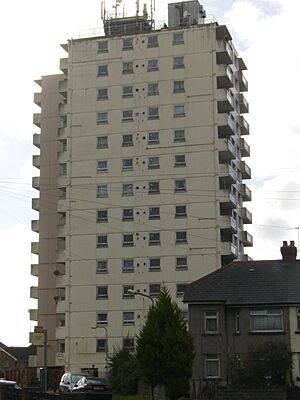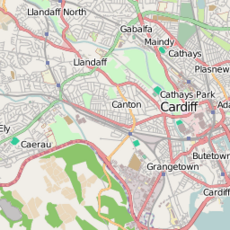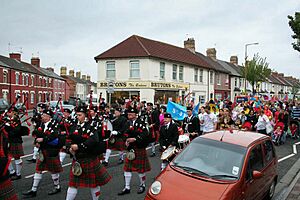Grangetown, Cardiff facts for kids
Quick facts for kids Grangetown |
|
|---|---|
 Channel View Flats, the tallest building in Grangetown |
|
| Population | 19,385 (2011) |
| OS grid reference | ST1774 |
| Community |
|
| Principal area | |
| Ceremonial county | |
| Country | Wales |
| Sovereign state | United Kingdom |
| Post town | CARDIFF |
| Postcode district | CF11 |
| Dialling code | 029 |
| Police | South Wales |
| Fire | South Wales |
| Ambulance | Welsh |
| EU Parliament | Wales |
| UK Parliament |
|
| Welsh Assembly |
|
Grangetown is a lively area and community in the south of Cardiff, the capital city of Wales. It is one of the biggest areas in south Cardiff. It shares borders with Riverside, Canton, and Butetown. The River Taff flows right through Grangetown.
Grangetown is close to Cardiff Bay. It is currently seeing many improvements to its buildings and services. In 2011, about 19,385 people lived here in 8,261 homes. Grangetown is known for being a diverse place. Many people from different backgrounds, including Somali, Asian, and mixed-race residents, call it home. You can find a Swaminarayan Temple and several mosques here.
Contents
- What's in a Name? The Story of Grangetown
- A Look Back: Grangetown's History
- Places to Worship
- The Welsh Language in Grangetown
- Local Amenities and Fun Places
- Festivals and Events
- Sport and Leisure
- Famous People from Grangetown
- Getting Around: Transport
- Grangetown on TV and Film
- Recent Improvements
- Where is Grangetown?
- Images for kids
What's in a Name? The Story of Grangetown
The name Grangetown is the most common name for this area, even in Welsh. Sometimes, you might hear Y Grange or Y Grênj, which mean 'The Grange'. A 'grange' was a type of farm owned by monks.
The name comes from a 'moor' or saltmarsh where the original farm stood. This led to names like 'More Grange' or 'Grangemoor'.
A Look Back: Grangetown's History
From Farmland to Town
Before the mid-1800s, Grangetown was mostly wet, marshy land used for farming. Around the late 1100s, Cistercian monks from Margam Abbey were given this land. They built a special farm called a monastic grange here.
The monks were forced to leave around 1290 but returned in 1329. They kept the land until the dissolution of the monasteries, when many religious places were closed down.
The Grange Farm and New Homes
By the 1400s, the grange was rented out to regular people. The last farmer was Lewis ap Richard. After the monasteries closed, the farm stayed with Lewis's family. The family later moved to St Fagans Castle. The grange eventually passed to the Earls of Plymouth.
The old farmhouse, called Grange Farm, is still there today. But now, it's surrounded by many streets of brick houses. These houses were built in the 1800s for the many workers who came to Cardiff. They came to work in the busy docks and factories during the industrial boom.
Growing into a Suburb
Grangetown really started to grow after 1850. That's when Penarth Road and new bridges over the River Taff and River Ely were built. These connected Cardiff to Penarth. In 1857, Baroness Windsor, who owned the land, got permission to build homes here. She wanted to call the area 'The Grange'.
Grangetown officially became a part of Cardiff in 1875. The area was quite low, so it sometimes flooded. In 1883, the sea flooded parts of Grangetown up to five feet deep!
World War II and Local Heroes
During World War II, Grangetown was attacked in the Cardiff Blitz. On January 2, 1941, German planes bombed Cardiff for over 10 hours. A bakery cellar on Corporation Road was used as a shelter. Sadly, 32 people hiding there were killed.
Today, a hardware shop stands on that spot. A plaque on the building remembers the victims.
Famous Pies and More
Cardiff's much-loved Clark's Pies came to Grangetown in 1955. Dennis Dutch, a descendant of the original founders, opened a shop on Bromsgrove Street. You can still buy their famous pies there today!
Places to Worship
Grangetown has many different places of worship. There are at least ten Christian churches, including Grangetown Baptist Church and the Salvation Army. You can also find a Hindu temple on Merches Place and mosques like Masjid Abu Bakr on Clydach Street and Markaz At-Tawheed on Penarth Road.
St Paul's Church on Paget Street was built between 1889 and 1902. It has a unique design using different types of stone. St Patrick's Church is the local Catholic church. St Dyfrig and St Samson, on Pentre Gardens, dates from 1911.
The Welsh Language in Grangetown
More and more people in Grangetown are speaking Welsh! The number of Welsh speakers over three years old grew from 1,217 in 2001 to 1,867 in 2011. This shows a big increase in the use of the Welsh language in the area.
Grangetown was home to Cardiff's very first Welsh-medium primary school class. It opened in 1949 with just 8 students at what is now Ninian Park Primary School. A plaque at the school remembers this important event.
Local Amenities and Fun Places
Tramshed: Music and Entertainment
The Tramshed is a popular music and entertainment spot in Cardiff. It opened in October 2015. This venue is in an old tram depot from 1902. It can hold up to 1000 people for concerts and shows.
Grangetown Hub: More Than a Library
The Grangetown Library opened in 2007 on Havelock Place. It has since been updated and is now called The Hub (or Yr Hyb in Welsh). It still offers library services but also helps residents access more council services.
Leisure Centres: Stay Active!
- The Channel View Leisure Centre is in the south of Grangetown. It has a gym, sports halls, an outdoor astro pitch, and even a climbing wall.
- The Cardiff International Sports Village is also nearby. It features the Cardiff International Pool and the Cardiff Arena.
Parks and Gardens: Green Spaces
Grangetown has four public parks: Grange Gardens, Sevenoaks Park, the Marl, and Grangemoor Park. Grangemoor Park was built on an old rubbish tip and opened in 2000. Grange Gardens recently had a new building, Grange Pavilion, completed in 2020.
Shopping and More
You'll find three post offices in Grangetown. There are also many small local shops along Penarth Road and Corporation Road. For bigger stores, the Cardiff Bay Retail Park is close by.
Education: Schools in Grangetown
- Grangetown Nursery is for young children around 3 years old.
- Grangetown Primary School is an old Victorian school, built in 1884.
- St Patrick's School is a Roman Catholic primary school with about 250 students.
- Ninian Park School has over 400 students. It was built in 1899–1900 and was once the most expensive school in Cardiff.
- St Paul's School is a Church in Wales primary school with over 100 students.
Festivals and Events
Grangetown Festival
The Grangetown Festival happens every year for a week in June. It started in 1978 and is organized by Grangetown Community Action. The festival ends with a fun parade through the streets. The parade finishes in Grange Gardens, where a big carnival takes place.
Roxe Jam: Hip-Hop and Graffiti
The 'Roxe Jam' festival celebrates hip-hop and graffiti art. It used to take place every July in Sevenoaks Park. The festival started in 2008 to remember a young graffiti artist named Bill Lockwood, also known as Roxe. A main part of the event was painting a long wall next to the railway line. The last festival was in 2012.
Sport and Leisure
Baseball
Grangetown was once famous for its baseball teams, Grange Albion and Grange Catholics. They were very successful in Welsh baseball. Both teams played at Sevenoaks Park. Grange Albion celebrated 100 years in 2007. However, both clubs stopped playing due to a lack of players.
Cricket
Bay Dragons Cricket Club is based in Grangetown. They play in the South East Wales Cricket League.
Football
Grange Albion F.C. plays football at Coronation Park. They are part of the South Wales Alliance League.
Famous People from Grangetown
Many notable people have connections to Grangetown:
- John Davies – A famous historian who lived in Grangetown.
- Elfyn Lewis – An award-winning artist who lives in Grangetown.
- John Pugsley – A footballer who played for Cardiff City FC and the Wales national team. He was born in Grangetown.
- Maureen Rees – A British reality TV personality.
- Mark Ring – A Wales Rugby Union player. He also played for Grange Albion and Wales in Welsh baseball.
- Terry Yorath – A footballer and manager for Cardiff City FC and the Wales national team.
- Peter Wingfield – An actor.
Getting Around: Transport
Train Station
Grangetown railway station is on the Vale of Glamorgan Line. You can catch trains from here to Cardiff Central, Bridgend, Barry, Rhoose Cardiff International Airport, and Llantwit Major. There are also branch lines to Penarth and Barry Island.
Bus Services
Cardiff Bus runs several services through Grangetown:
- 1 City Circle (towards Canton)
- 2 City Circle (towards Cardiff Bay)
- 8 (Central Stn-Roath-Heath-University Hospital Wales) or (Cardiff Bay)
- 9/9A (Central Stn-Roath-Heath-University Hospital Wales) or (Cardiff International Sports Village) / (Channel View)
- 92 from Penarth Road (Penarth)
- 93/94 from Penarth Road (Penarth-Barry)
Main Roads
Penarth Road (A4160) is the main road in the area. It goes northeast towards Cardiff city centre and southwest towards Llandough, Dinas Powys, Penarth, and Barry. The Ferry Road Interchange on the Grangetown Link Road ((A4232)) connects to the M4 motorway at Junction 33 (Cardiff West).
Grangetown on TV and Film
The local church, St Paul's on Paget Street, was used as a filming location for the BBC show Doctor Who. It appeared in the episode Father's Day. In the story, strange monsters called 'Reapers' attack the church during a wedding. Filming happened there in November 2004.
Recent Improvements
From 2005 to 2013, the North Grangetown Renewal Area project helped improve 500 homes. This included new roofs, windows, and outside finishes. The project also added new trees and a public green space called Gerddi Courtmead Gardens.
Cardiff University's Community Gateway scheme also supports projects in Grangetown. These have included a youth forum and helping to fix up an old bowls pavilion in Grange Gardens.
Where is Grangetown?
| Canton | Riverside | City centre |
| Grangetown | Butetown | |
| Leckwith | Cardiff Bay |
Images for kids






